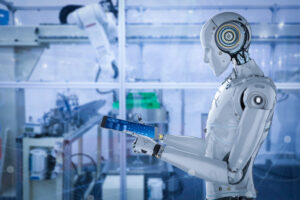
As automakers face growing competition, embracing the smart factory revolution in 2025 is no longer just a strategic advantage—it’s a necessity.
Auto manufacturers have turned to smart manufacturing technologies to bring cars to market with more driver-demanded features faster while dealing with more stringent regulations and supply chain issues. In the past, those technologies were essentially deployed and used independently; now, there is a move to higher-level smart factory strategies.
In particular, the industry should expect more interest in hyper-connected production environments seamlessly integrating AI, IoT, and automation. Such smart factories are becoming more than just an aspiration; they are a competitive necessity.
What’s New in Smart Factories in 2025?
The combination of AI-driven decision-making, real-time IoT monitoring, and autonomous robotics is expected to redefine manufacturing efficiency, cost reduction, and product quality.
Some of the changes that will have a great impact on the industry include:
AI-powered Predictive Manufacturing: Artificial intelligence has made significant strides in predictive maintenance and demand forecasting. In 2025, AI-driven analytics can accurately predict machine failures, preventing costly downtime and minimizing production disruptions.
Advanced machine learning models analyze sensor data in real time, identifying subtle anomalies before they turn into failures. Such an approach to predictive maintenance reduces repair costs and extends equipment life, ensuring factories run optimally.
Moreover, AI-driven forecasting can now incorporate real-time supply chain analytics, consumer demand trends, and external factors like geopolitical events, allowing automakers to dynamically adjust production schedules and reduce excess inventory.
Edge Computing and IoT for Real-time Decision-making: IoT technology has been a key component of smart factories, but in 2025, edge computing is taking it to the next level. Instead of relying solely on cloud-based data processing, edge devices process data locally on the factory floor, enabling real-time decision-making with ultra-low latency.
For example, smart sensors embedded in robotic assembly lines can instantly detect defects and make immediate corrections, reducing waste and improving product quality. Additionally, connected IoT systems provide real-time energy management insights, allowing factories to optimize energy usage and cut costs—a crucial factor as sustainability pressures mount.
AI-driven Autonomous Production Lines: Automation is no longer just about replacing repetitive tasks with robots. In 2025, smart factories will increasingly leverage AI-driven collaborative robots (cobots) to self-optimize and adapt to real-time production changes.
Such advanced cobots work alongside human operators, learning and improving over time. Unlike traditional robots that follow pre-programmed instructions, AI-powered cobots adjust to variations in assembly processes, handle multiple vehicle models, and even identify quality issues on their own.
This level of autonomy is particularly beneficial in an era where automakers face labor shortages and increasingly shift toward customized vehicle production, requiring greater flexibility in manufacturing processes.
AI-Optimized Supply Chain Resilience: Supply chain disruptions have recently plagued the automotive industry. By analyzing vast amounts of global logistics data, AI can be used to predict potential disruptions—such as material shortages or geopolitical trade issues—and suggest alternative suppliers in real time.
Additionally, AI tools can enhance traceability and compliance by ensuring that every component used in manufacturing is sourced ethically and meets regulatory standards.
Generative AI for Factory Design and Optimization: The use of generative AI for factory layout and process optimization is expected to gain ground in 2025. Automakers can design and optimize factory workflows before physical implementation using digital twins and AI-powered simulations, drastically reducing trial-and-error costs.
These AI-driven simulations help maximize floor space, improve assembly line efficiency, and identify bottlenecks before they occur in real production settings.
See also: Making Smart Manufacturing Smarter with AI
The Business Benefits of Smart Factory Transformation
Once these technologies are implemented and automakers integrate AI, IoT, and automation, they can expect to realize a range of benefits. Some of the prime benefits include:
- Increased Efficiency & Productivity – AI and automation significantly reduce cycle times, allowing factories to produce more vehicles with fewer disruptions.
- Reduced Operational Costs – Predictive maintenance, AI-driven energy management, and automation reduce waste and lower overall manufacturing expenses.
- Higher Quality and Lower Defect Rates – AI-powered defect detection systems enhance product consistency and reduce recalls.
- Supply Chain Agility – AI-powered analytics provide real-time visibility into logistics and materials, allowing for swift adjustments in case of disruptions.
- Sustainability and ESG Compliance – Smart factories enable energy-efficient operations, helping automakers meet global sustainability targets and reduce their carbon footprint.
- Greater Customization Capability – With AI-driven flexible production lines, automakers can cater to increasing consumer demand for customized vehicles without excessive retooling costs.
The bottom line is that as automakers face growing competition, embracing the smart factory revolution in 2025 is no longer just a strategic advantage—it’s a necessity. To that end, the convergence of AI, IoT, and automation improves efficiency and cost-effectiveness and positions automakers for future innovations.
Auto manufacturers and tier 1 partners who invest in smart manufacturing today will be tomorrow’s industry leaders. The question isn’t whether an organization should transition to a smart factory—it’s how fast they can make it happen.







